Nursing Case Study: Clinical Reasoning and Miller's Theory
VerifiedAdded on 2023/06/13
|11
|3064
|473
Case Study
AI Summary
This nursing assignment presents a case study of Amalie Jones, an 89-year-old woman with a medical history including arthritis, hypothyroidism, and macular degeneration. The assignment uses Miller’s Functional Consequences Theory and Levett-Jones’ Clinical Reasoning Cycle to identify and prioritize nursing care issues. It details the assessment of Amalie's condition, problem identification (vision deficit, joint stiffness, and limited mobility), and the establishment of SMART goals focused on reducing fall risk and improving mobility. Nursing interventions include resistance training exercises, patient education on safety measures, and environmental modifications. The assignment concludes with an evaluation of the interventions' effectiveness and a reflection on the learning process, emphasizing the importance of holistic geriatric care and the application of clinical reasoning in nursing practice. Desklib offers a platform for students to access similar solved assignments and past papers for enhanced learning.
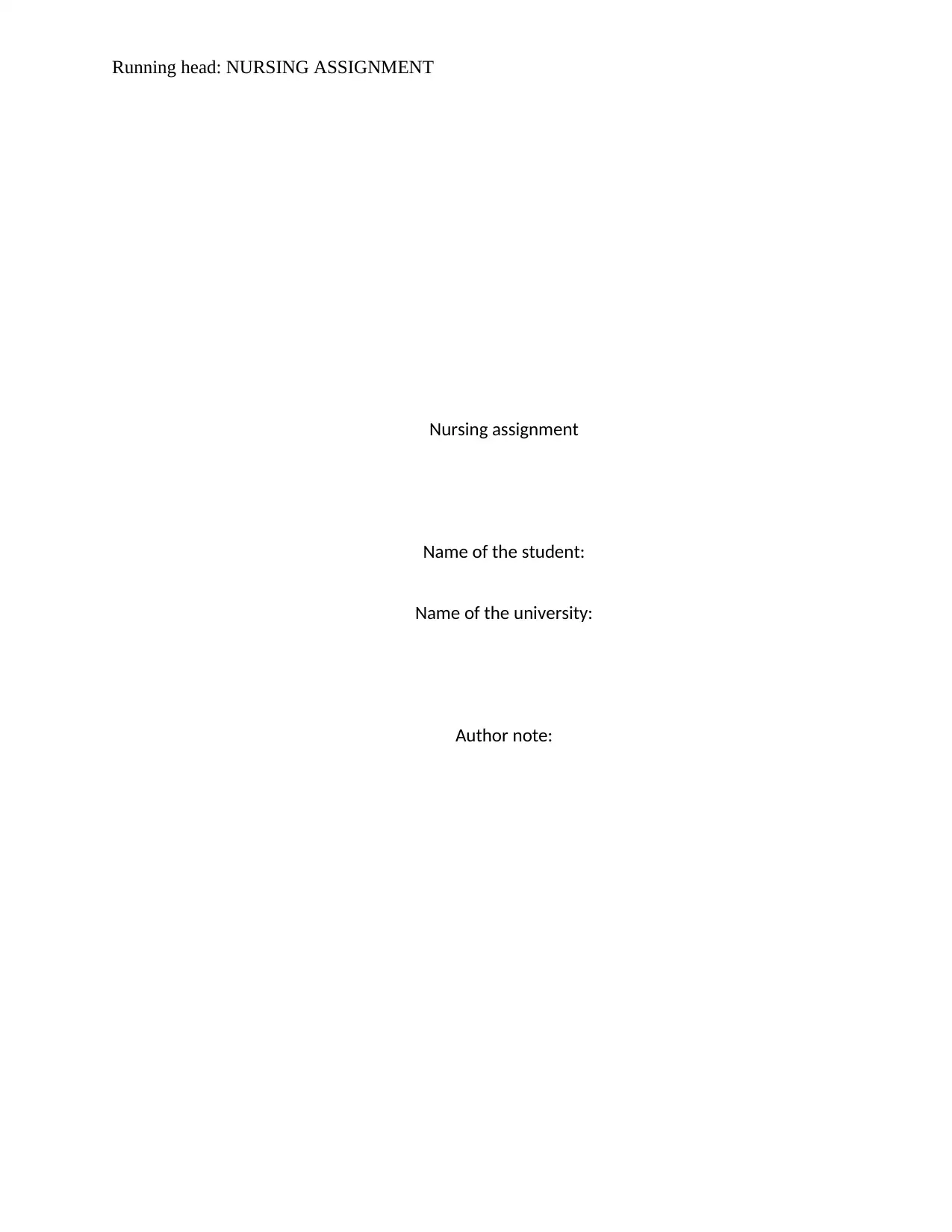
Running head: NURSING ASSIGNMENT
Nursing assignment
Name of the student:
Name of the university:
Author note:
Nursing assignment
Name of the student:
Name of the university:
Author note:
Paraphrase This Document
Need a fresh take? Get an instant paraphrase of this document with our AI Paraphraser

1NURSING ASSIGNMENT
Table of Contents
Introduction..........................................................................................................................2
Part A...................................................................................................................................2
Part B...................................................................................................................................4
Conclusion...........................................................................................................................6
References............................................................................................................................8
Table of Contents
Introduction..........................................................................................................................2
Part A...................................................................................................................................2
Part B...................................................................................................................................4
Conclusion...........................................................................................................................6
References............................................................................................................................8
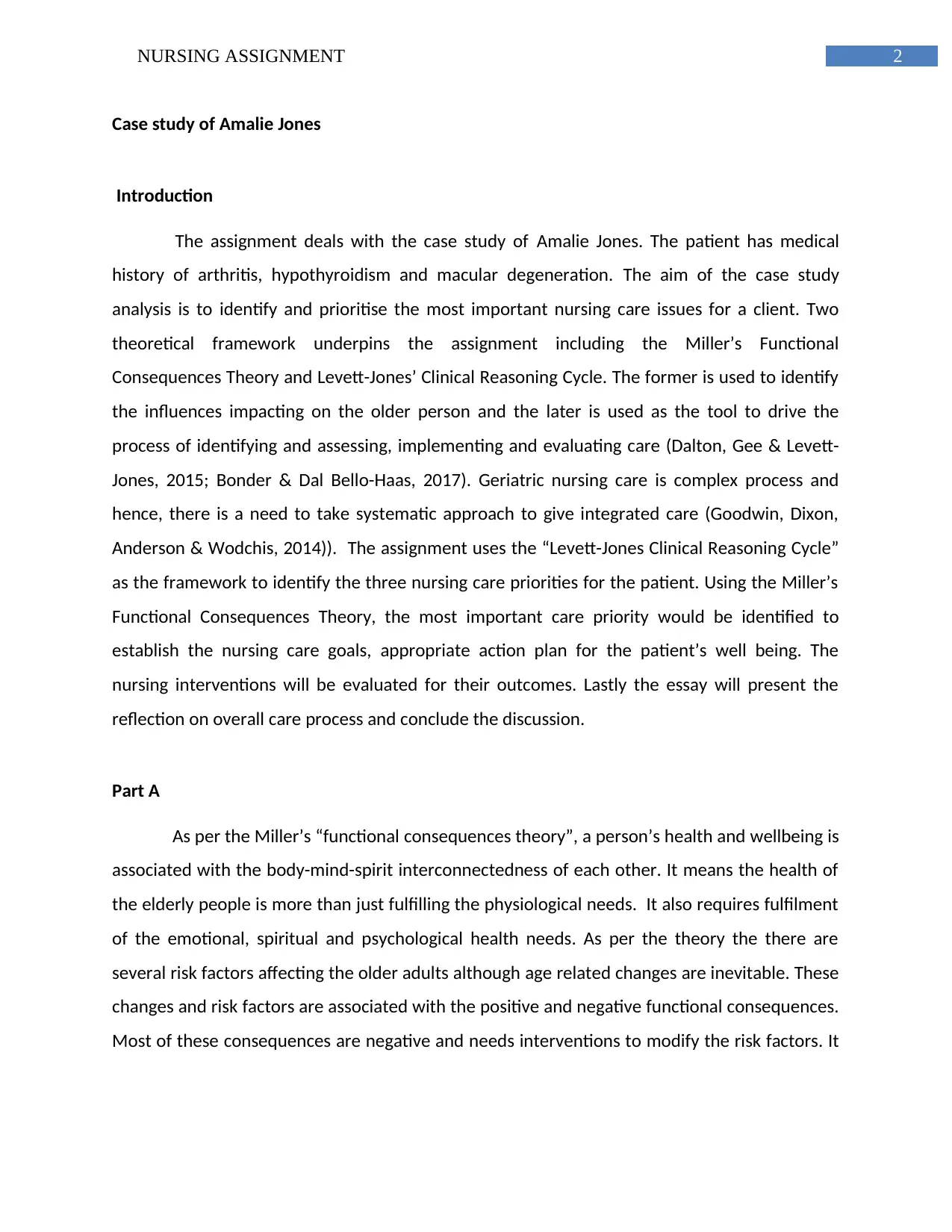
2NURSING ASSIGNMENT
Case study of Amalie Jones
Introduction
The assignment deals with the case study of Amalie Jones. The patient has medical
history of arthritis, hypothyroidism and macular degeneration. The aim of the case study
analysis is to identify and prioritise the most important nursing care issues for a client. Two
theoretical framework underpins the assignment including the Miller’s Functional
Consequences Theory and Levett-Jones’ Clinical Reasoning Cycle. The former is used to identify
the influences impacting on the older person and the later is used as the tool to drive the
process of identifying and assessing, implementing and evaluating care (Dalton, Gee & Levett-
Jones, 2015; Bonder & Dal Bello-Haas, 2017). Geriatric nursing care is complex process and
hence, there is a need to take systematic approach to give integrated care (Goodwin, Dixon,
Anderson & Wodchis, 2014)). The assignment uses the “Levett-Jones Clinical Reasoning Cycle”
as the framework to identify the three nursing care priorities for the patient. Using the Miller’s
Functional Consequences Theory, the most important care priority would be identified to
establish the nursing care goals, appropriate action plan for the patient’s well being. The
nursing interventions will be evaluated for their outcomes. Lastly the essay will present the
reflection on overall care process and conclude the discussion.
Part A
As per the Miller’s “functional consequences theory”, a person’s health and wellbeing is
associated with the body-mind-spirit interconnectedness of each other. It means the health of
the elderly people is more than just fulfilling the physiological needs. It also requires fulfilment
of the emotional, spiritual and psychological health needs. As per the theory the there are
several risk factors affecting the older adults although age related changes are inevitable. These
changes and risk factors are associated with the positive and negative functional consequences.
Most of these consequences are negative and needs interventions to modify the risk factors. It
Case study of Amalie Jones
Introduction
The assignment deals with the case study of Amalie Jones. The patient has medical
history of arthritis, hypothyroidism and macular degeneration. The aim of the case study
analysis is to identify and prioritise the most important nursing care issues for a client. Two
theoretical framework underpins the assignment including the Miller’s Functional
Consequences Theory and Levett-Jones’ Clinical Reasoning Cycle. The former is used to identify
the influences impacting on the older person and the later is used as the tool to drive the
process of identifying and assessing, implementing and evaluating care (Dalton, Gee & Levett-
Jones, 2015; Bonder & Dal Bello-Haas, 2017). Geriatric nursing care is complex process and
hence, there is a need to take systematic approach to give integrated care (Goodwin, Dixon,
Anderson & Wodchis, 2014)). The assignment uses the “Levett-Jones Clinical Reasoning Cycle”
as the framework to identify the three nursing care priorities for the patient. Using the Miller’s
Functional Consequences Theory, the most important care priority would be identified to
establish the nursing care goals, appropriate action plan for the patient’s well being. The
nursing interventions will be evaluated for their outcomes. Lastly the essay will present the
reflection on overall care process and conclude the discussion.
Part A
As per the Miller’s “functional consequences theory”, a person’s health and wellbeing is
associated with the body-mind-spirit interconnectedness of each other. It means the health of
the elderly people is more than just fulfilling the physiological needs. It also requires fulfilment
of the emotional, spiritual and psychological health needs. As per the theory the there are
several risk factors affecting the older adults although age related changes are inevitable. These
changes and risk factors are associated with the positive and negative functional consequences.
Most of these consequences are negative and needs interventions to modify the risk factors. It
⊘ This is a preview!⊘
Do you want full access?
Subscribe today to unlock all pages.

Trusted by 1+ million students worldwide
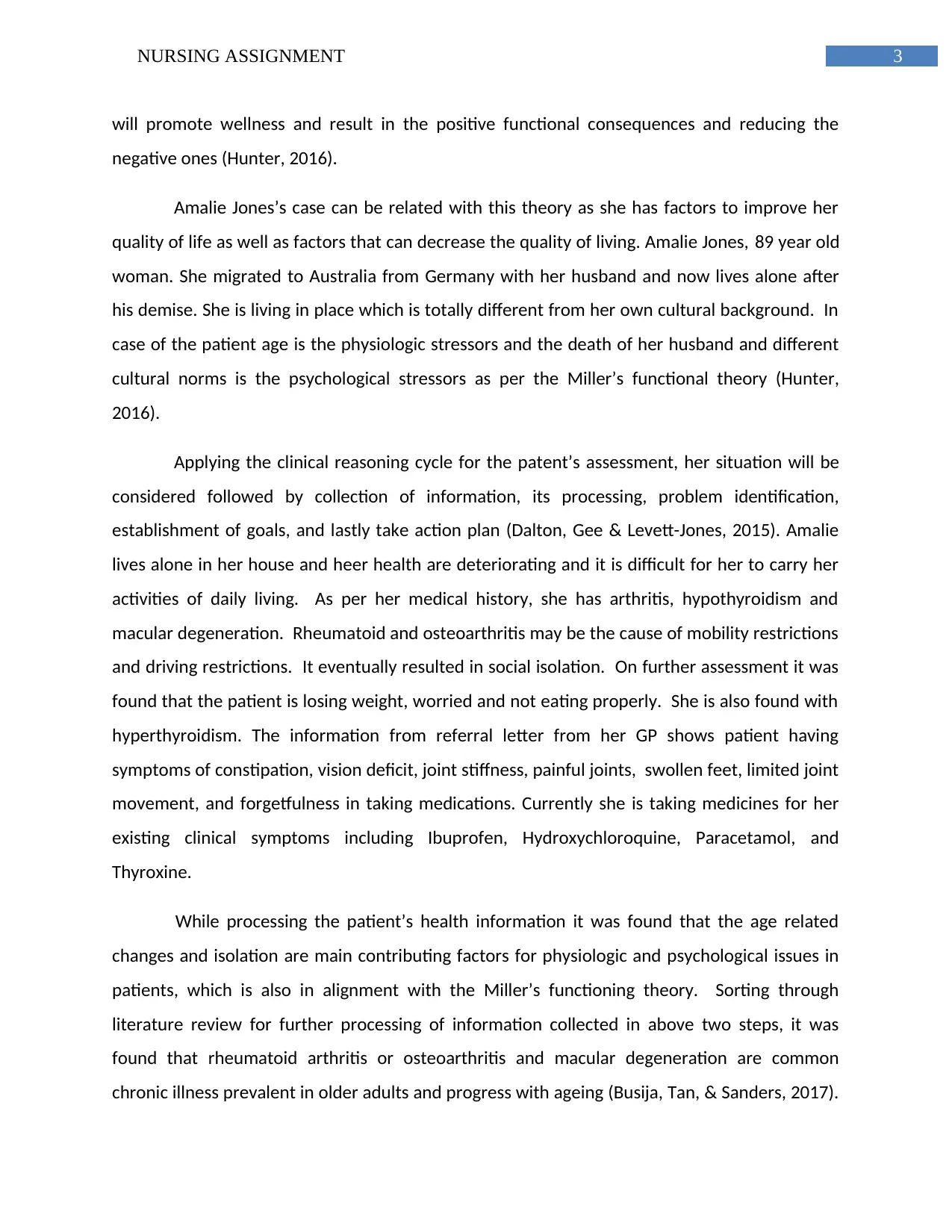
3NURSING ASSIGNMENT
will promote wellness and result in the positive functional consequences and reducing the
negative ones (Hunter, 2016).
Amalie Jones’s case can be related with this theory as she has factors to improve her
quality of life as well as factors that can decrease the quality of living. Amalie Jones, 89 year old
woman. She migrated to Australia from Germany with her husband and now lives alone after
his demise. She is living in place which is totally different from her own cultural background. In
case of the patient age is the physiologic stressors and the death of her husband and different
cultural norms is the psychological stressors as per the Miller’s functional theory (Hunter,
2016).
Applying the clinical reasoning cycle for the patent’s assessment, her situation will be
considered followed by collection of information, its processing, problem identification,
establishment of goals, and lastly take action plan (Dalton, Gee & Levett-Jones, 2015). Amalie
lives alone in her house and heer health are deteriorating and it is difficult for her to carry her
activities of daily living. As per her medical history, she has arthritis, hypothyroidism and
macular degeneration. Rheumatoid and osteoarthritis may be the cause of mobility restrictions
and driving restrictions. It eventually resulted in social isolation. On further assessment it was
found that the patient is losing weight, worried and not eating properly. She is also found with
hyperthyroidism. The information from referral letter from her GP shows patient having
symptoms of constipation, vision deficit, joint stiffness, painful joints, swollen feet, limited joint
movement, and forgetfulness in taking medications. Currently she is taking medicines for her
existing clinical symptoms including Ibuprofen, Hydroxychloroquine, Paracetamol, and
Thyroxine.
While processing the patient’s health information it was found that the age related
changes and isolation are main contributing factors for physiologic and psychological issues in
patients, which is also in alignment with the Miller’s functioning theory. Sorting through
literature review for further processing of information collected in above two steps, it was
found that rheumatoid arthritis or osteoarthritis and macular degeneration are common
chronic illness prevalent in older adults and progress with ageing (Busija, Tan, & Sanders, 2017).
will promote wellness and result in the positive functional consequences and reducing the
negative ones (Hunter, 2016).
Amalie Jones’s case can be related with this theory as she has factors to improve her
quality of life as well as factors that can decrease the quality of living. Amalie Jones, 89 year old
woman. She migrated to Australia from Germany with her husband and now lives alone after
his demise. She is living in place which is totally different from her own cultural background. In
case of the patient age is the physiologic stressors and the death of her husband and different
cultural norms is the psychological stressors as per the Miller’s functional theory (Hunter,
2016).
Applying the clinical reasoning cycle for the patent’s assessment, her situation will be
considered followed by collection of information, its processing, problem identification,
establishment of goals, and lastly take action plan (Dalton, Gee & Levett-Jones, 2015). Amalie
lives alone in her house and heer health are deteriorating and it is difficult for her to carry her
activities of daily living. As per her medical history, she has arthritis, hypothyroidism and
macular degeneration. Rheumatoid and osteoarthritis may be the cause of mobility restrictions
and driving restrictions. It eventually resulted in social isolation. On further assessment it was
found that the patient is losing weight, worried and not eating properly. She is also found with
hyperthyroidism. The information from referral letter from her GP shows patient having
symptoms of constipation, vision deficit, joint stiffness, painful joints, swollen feet, limited joint
movement, and forgetfulness in taking medications. Currently she is taking medicines for her
existing clinical symptoms including Ibuprofen, Hydroxychloroquine, Paracetamol, and
Thyroxine.
While processing the patient’s health information it was found that the age related
changes and isolation are main contributing factors for physiologic and psychological issues in
patients, which is also in alignment with the Miller’s functioning theory. Sorting through
literature review for further processing of information collected in above two steps, it was
found that rheumatoid arthritis or osteoarthritis and macular degeneration are common
chronic illness prevalent in older adults and progress with ageing (Busija, Tan, & Sanders, 2017).
Paraphrase This Document
Need a fresh take? Get an instant paraphrase of this document with our AI Paraphraser
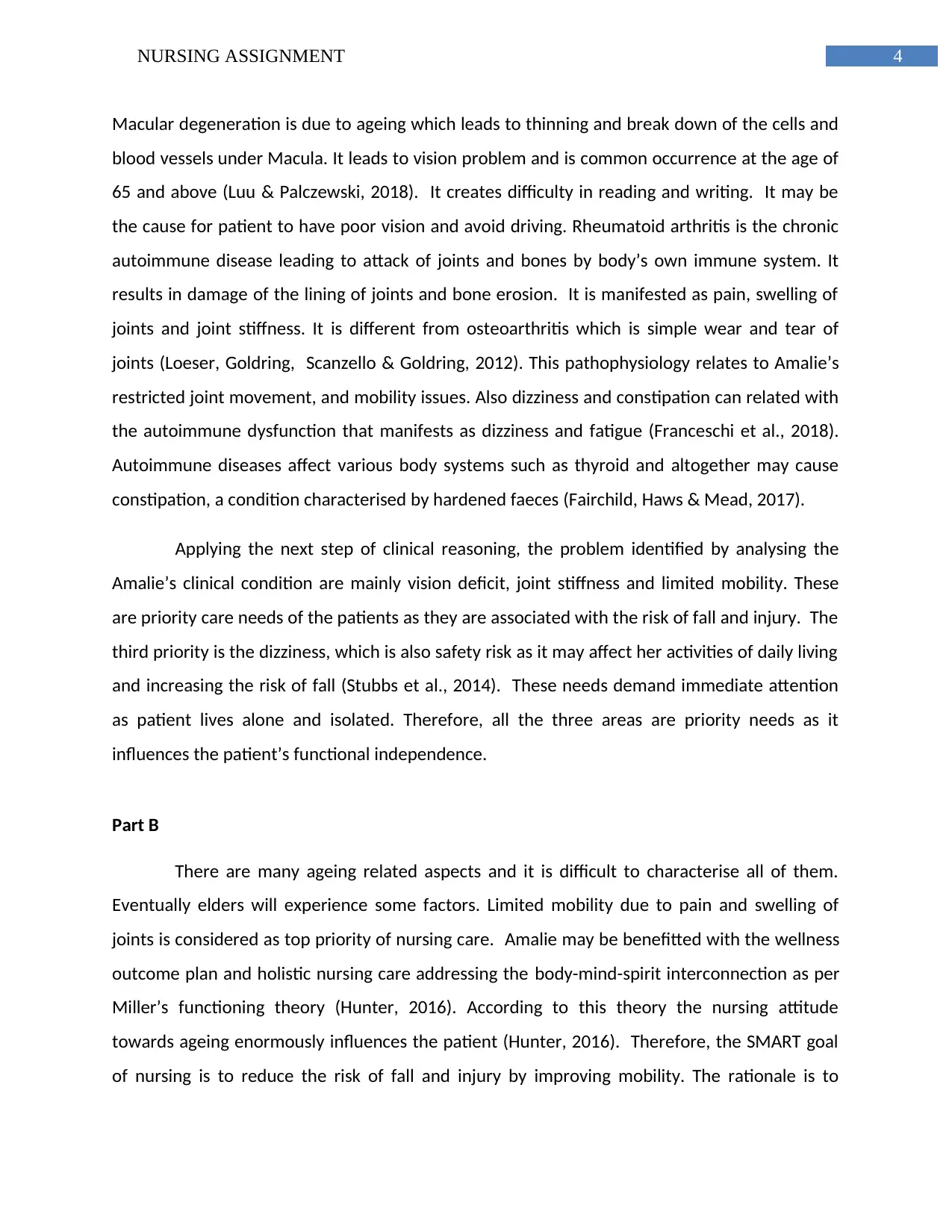
4NURSING ASSIGNMENT
Macular degeneration is due to ageing which leads to thinning and break down of the cells and
blood vessels under Macula. It leads to vision problem and is common occurrence at the age of
65 and above (Luu & Palczewski, 2018). It creates difficulty in reading and writing. It may be
the cause for patient to have poor vision and avoid driving. Rheumatoid arthritis is the chronic
autoimmune disease leading to attack of joints and bones by body’s own immune system. It
results in damage of the lining of joints and bone erosion. It is manifested as pain, swelling of
joints and joint stiffness. It is different from osteoarthritis which is simple wear and tear of
joints (Loeser, Goldring, Scanzello & Goldring, 2012). This pathophysiology relates to Amalie’s
restricted joint movement, and mobility issues. Also dizziness and constipation can related with
the autoimmune dysfunction that manifests as dizziness and fatigue (Franceschi et al., 2018).
Autoimmune diseases affect various body systems such as thyroid and altogether may cause
constipation, a condition characterised by hardened faeces (Fairchild, Haws & Mead, 2017).
Applying the next step of clinical reasoning, the problem identified by analysing the
Amalie’s clinical condition are mainly vision deficit, joint stiffness and limited mobility. These
are priority care needs of the patients as they are associated with the risk of fall and injury. The
third priority is the dizziness, which is also safety risk as it may affect her activities of daily living
and increasing the risk of fall (Stubbs et al., 2014). These needs demand immediate attention
as patient lives alone and isolated. Therefore, all the three areas are priority needs as it
influences the patient’s functional independence.
Part B
There are many ageing related aspects and it is difficult to characterise all of them.
Eventually elders will experience some factors. Limited mobility due to pain and swelling of
joints is considered as top priority of nursing care. Amalie may be benefitted with the wellness
outcome plan and holistic nursing care addressing the body-mind-spirit interconnection as per
Miller’s functioning theory (Hunter, 2016). According to this theory the nursing attitude
towards ageing enormously influences the patient (Hunter, 2016). Therefore, the SMART goal
of nursing is to reduce the risk of fall and injury by improving mobility. The rationale is to
Macular degeneration is due to ageing which leads to thinning and break down of the cells and
blood vessels under Macula. It leads to vision problem and is common occurrence at the age of
65 and above (Luu & Palczewski, 2018). It creates difficulty in reading and writing. It may be
the cause for patient to have poor vision and avoid driving. Rheumatoid arthritis is the chronic
autoimmune disease leading to attack of joints and bones by body’s own immune system. It
results in damage of the lining of joints and bone erosion. It is manifested as pain, swelling of
joints and joint stiffness. It is different from osteoarthritis which is simple wear and tear of
joints (Loeser, Goldring, Scanzello & Goldring, 2012). This pathophysiology relates to Amalie’s
restricted joint movement, and mobility issues. Also dizziness and constipation can related with
the autoimmune dysfunction that manifests as dizziness and fatigue (Franceschi et al., 2018).
Autoimmune diseases affect various body systems such as thyroid and altogether may cause
constipation, a condition characterised by hardened faeces (Fairchild, Haws & Mead, 2017).
Applying the next step of clinical reasoning, the problem identified by analysing the
Amalie’s clinical condition are mainly vision deficit, joint stiffness and limited mobility. These
are priority care needs of the patients as they are associated with the risk of fall and injury. The
third priority is the dizziness, which is also safety risk as it may affect her activities of daily living
and increasing the risk of fall (Stubbs et al., 2014). These needs demand immediate attention
as patient lives alone and isolated. Therefore, all the three areas are priority needs as it
influences the patient’s functional independence.
Part B
There are many ageing related aspects and it is difficult to characterise all of them.
Eventually elders will experience some factors. Limited mobility due to pain and swelling of
joints is considered as top priority of nursing care. Amalie may be benefitted with the wellness
outcome plan and holistic nursing care addressing the body-mind-spirit interconnection as per
Miller’s functioning theory (Hunter, 2016). According to this theory the nursing attitude
towards ageing enormously influences the patient (Hunter, 2016). Therefore, the SMART goal
of nursing is to reduce the risk of fall and injury by improving mobility. The rationale is to
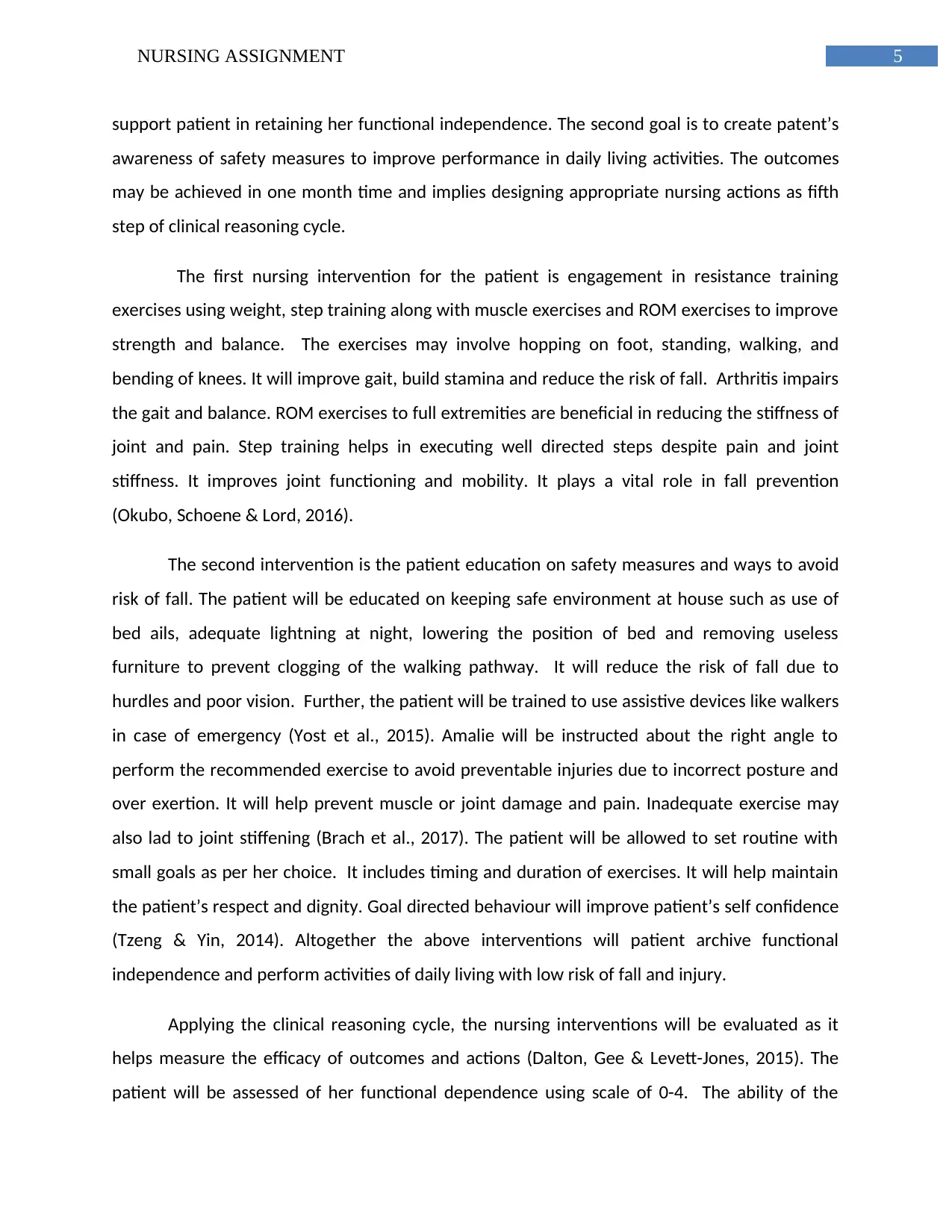
5NURSING ASSIGNMENT
support patient in retaining her functional independence. The second goal is to create patent’s
awareness of safety measures to improve performance in daily living activities. The outcomes
may be achieved in one month time and implies designing appropriate nursing actions as fifth
step of clinical reasoning cycle.
The first nursing intervention for the patient is engagement in resistance training
exercises using weight, step training along with muscle exercises and ROM exercises to improve
strength and balance. The exercises may involve hopping on foot, standing, walking, and
bending of knees. It will improve gait, build stamina and reduce the risk of fall. Arthritis impairs
the gait and balance. ROM exercises to full extremities are beneficial in reducing the stiffness of
joint and pain. Step training helps in executing well directed steps despite pain and joint
stiffness. It improves joint functioning and mobility. It plays a vital role in fall prevention
(Okubo, Schoene & Lord, 2016).
The second intervention is the patient education on safety measures and ways to avoid
risk of fall. The patient will be educated on keeping safe environment at house such as use of
bed ails, adequate lightning at night, lowering the position of bed and removing useless
furniture to prevent clogging of the walking pathway. It will reduce the risk of fall due to
hurdles and poor vision. Further, the patient will be trained to use assistive devices like walkers
in case of emergency (Yost et al., 2015). Amalie will be instructed about the right angle to
perform the recommended exercise to avoid preventable injuries due to incorrect posture and
over exertion. It will help prevent muscle or joint damage and pain. Inadequate exercise may
also lad to joint stiffening (Brach et al., 2017). The patient will be allowed to set routine with
small goals as per her choice. It includes timing and duration of exercises. It will help maintain
the patient’s respect and dignity. Goal directed behaviour will improve patient’s self confidence
(Tzeng & Yin, 2014). Altogether the above interventions will patient archive functional
independence and perform activities of daily living with low risk of fall and injury.
Applying the clinical reasoning cycle, the nursing interventions will be evaluated as it
helps measure the efficacy of outcomes and actions (Dalton, Gee & Levett-Jones, 2015). The
patient will be assessed of her functional dependence using scale of 0-4. The ability of the
support patient in retaining her functional independence. The second goal is to create patent’s
awareness of safety measures to improve performance in daily living activities. The outcomes
may be achieved in one month time and implies designing appropriate nursing actions as fifth
step of clinical reasoning cycle.
The first nursing intervention for the patient is engagement in resistance training
exercises using weight, step training along with muscle exercises and ROM exercises to improve
strength and balance. The exercises may involve hopping on foot, standing, walking, and
bending of knees. It will improve gait, build stamina and reduce the risk of fall. Arthritis impairs
the gait and balance. ROM exercises to full extremities are beneficial in reducing the stiffness of
joint and pain. Step training helps in executing well directed steps despite pain and joint
stiffness. It improves joint functioning and mobility. It plays a vital role in fall prevention
(Okubo, Schoene & Lord, 2016).
The second intervention is the patient education on safety measures and ways to avoid
risk of fall. The patient will be educated on keeping safe environment at house such as use of
bed ails, adequate lightning at night, lowering the position of bed and removing useless
furniture to prevent clogging of the walking pathway. It will reduce the risk of fall due to
hurdles and poor vision. Further, the patient will be trained to use assistive devices like walkers
in case of emergency (Yost et al., 2015). Amalie will be instructed about the right angle to
perform the recommended exercise to avoid preventable injuries due to incorrect posture and
over exertion. It will help prevent muscle or joint damage and pain. Inadequate exercise may
also lad to joint stiffening (Brach et al., 2017). The patient will be allowed to set routine with
small goals as per her choice. It includes timing and duration of exercises. It will help maintain
the patient’s respect and dignity. Goal directed behaviour will improve patient’s self confidence
(Tzeng & Yin, 2014). Altogether the above interventions will patient archive functional
independence and perform activities of daily living with low risk of fall and injury.
Applying the clinical reasoning cycle, the nursing interventions will be evaluated as it
helps measure the efficacy of outcomes and actions (Dalton, Gee & Levett-Jones, 2015). The
patient will be assessed of her functional dependence using scale of 0-4. The ability of the
⊘ This is a preview!⊘
Do you want full access?
Subscribe today to unlock all pages.

Trusted by 1+ million students worldwide
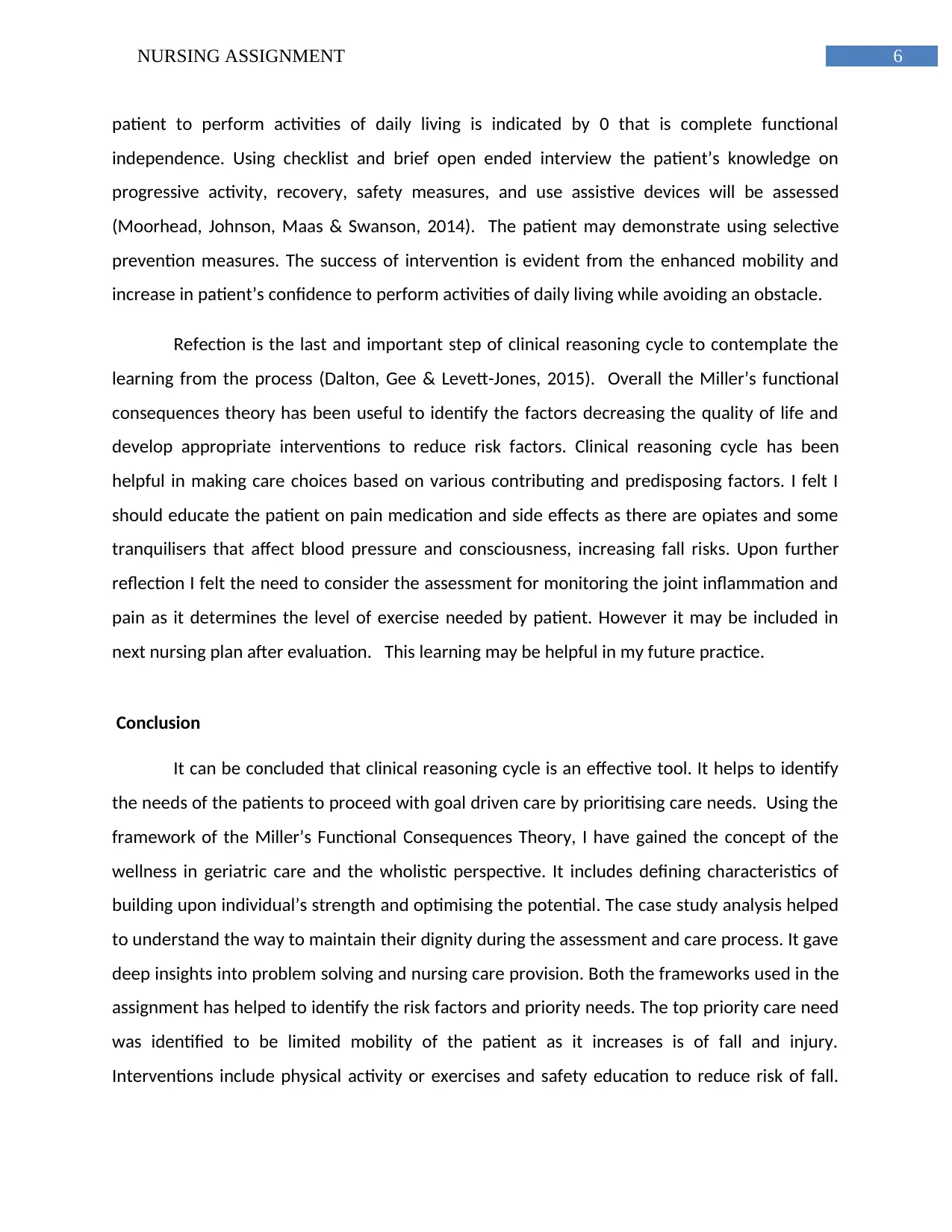
6NURSING ASSIGNMENT
patient to perform activities of daily living is indicated by 0 that is complete functional
independence. Using checklist and brief open ended interview the patient’s knowledge on
progressive activity, recovery, safety measures, and use assistive devices will be assessed
(Moorhead, Johnson, Maas & Swanson, 2014). The patient may demonstrate using selective
prevention measures. The success of intervention is evident from the enhanced mobility and
increase in patient’s confidence to perform activities of daily living while avoiding an obstacle.
Refection is the last and important step of clinical reasoning cycle to contemplate the
learning from the process (Dalton, Gee & Levett-Jones, 2015). Overall the Miller’s functional
consequences theory has been useful to identify the factors decreasing the quality of life and
develop appropriate interventions to reduce risk factors. Clinical reasoning cycle has been
helpful in making care choices based on various contributing and predisposing factors. I felt I
should educate the patient on pain medication and side effects as there are opiates and some
tranquilisers that affect blood pressure and consciousness, increasing fall risks. Upon further
reflection I felt the need to consider the assessment for monitoring the joint inflammation and
pain as it determines the level of exercise needed by patient. However it may be included in
next nursing plan after evaluation. This learning may be helpful in my future practice.
Conclusion
It can be concluded that clinical reasoning cycle is an effective tool. It helps to identify
the needs of the patients to proceed with goal driven care by prioritising care needs. Using the
framework of the Miller’s Functional Consequences Theory, I have gained the concept of the
wellness in geriatric care and the wholistic perspective. It includes defining characteristics of
building upon individual’s strength and optimising the potential. The case study analysis helped
to understand the way to maintain their dignity during the assessment and care process. It gave
deep insights into problem solving and nursing care provision. Both the frameworks used in the
assignment has helped to identify the risk factors and priority needs. The top priority care need
was identified to be limited mobility of the patient as it increases is of fall and injury.
Interventions include physical activity or exercises and safety education to reduce risk of fall.
patient to perform activities of daily living is indicated by 0 that is complete functional
independence. Using checklist and brief open ended interview the patient’s knowledge on
progressive activity, recovery, safety measures, and use assistive devices will be assessed
(Moorhead, Johnson, Maas & Swanson, 2014). The patient may demonstrate using selective
prevention measures. The success of intervention is evident from the enhanced mobility and
increase in patient’s confidence to perform activities of daily living while avoiding an obstacle.
Refection is the last and important step of clinical reasoning cycle to contemplate the
learning from the process (Dalton, Gee & Levett-Jones, 2015). Overall the Miller’s functional
consequences theory has been useful to identify the factors decreasing the quality of life and
develop appropriate interventions to reduce risk factors. Clinical reasoning cycle has been
helpful in making care choices based on various contributing and predisposing factors. I felt I
should educate the patient on pain medication and side effects as there are opiates and some
tranquilisers that affect blood pressure and consciousness, increasing fall risks. Upon further
reflection I felt the need to consider the assessment for monitoring the joint inflammation and
pain as it determines the level of exercise needed by patient. However it may be included in
next nursing plan after evaluation. This learning may be helpful in my future practice.
Conclusion
It can be concluded that clinical reasoning cycle is an effective tool. It helps to identify
the needs of the patients to proceed with goal driven care by prioritising care needs. Using the
framework of the Miller’s Functional Consequences Theory, I have gained the concept of the
wellness in geriatric care and the wholistic perspective. It includes defining characteristics of
building upon individual’s strength and optimising the potential. The case study analysis helped
to understand the way to maintain their dignity during the assessment and care process. It gave
deep insights into problem solving and nursing care provision. Both the frameworks used in the
assignment has helped to identify the risk factors and priority needs. The top priority care need
was identified to be limited mobility of the patient as it increases is of fall and injury.
Interventions include physical activity or exercises and safety education to reduce risk of fall.
Paraphrase This Document
Need a fresh take? Get an instant paraphrase of this document with our AI Paraphraser
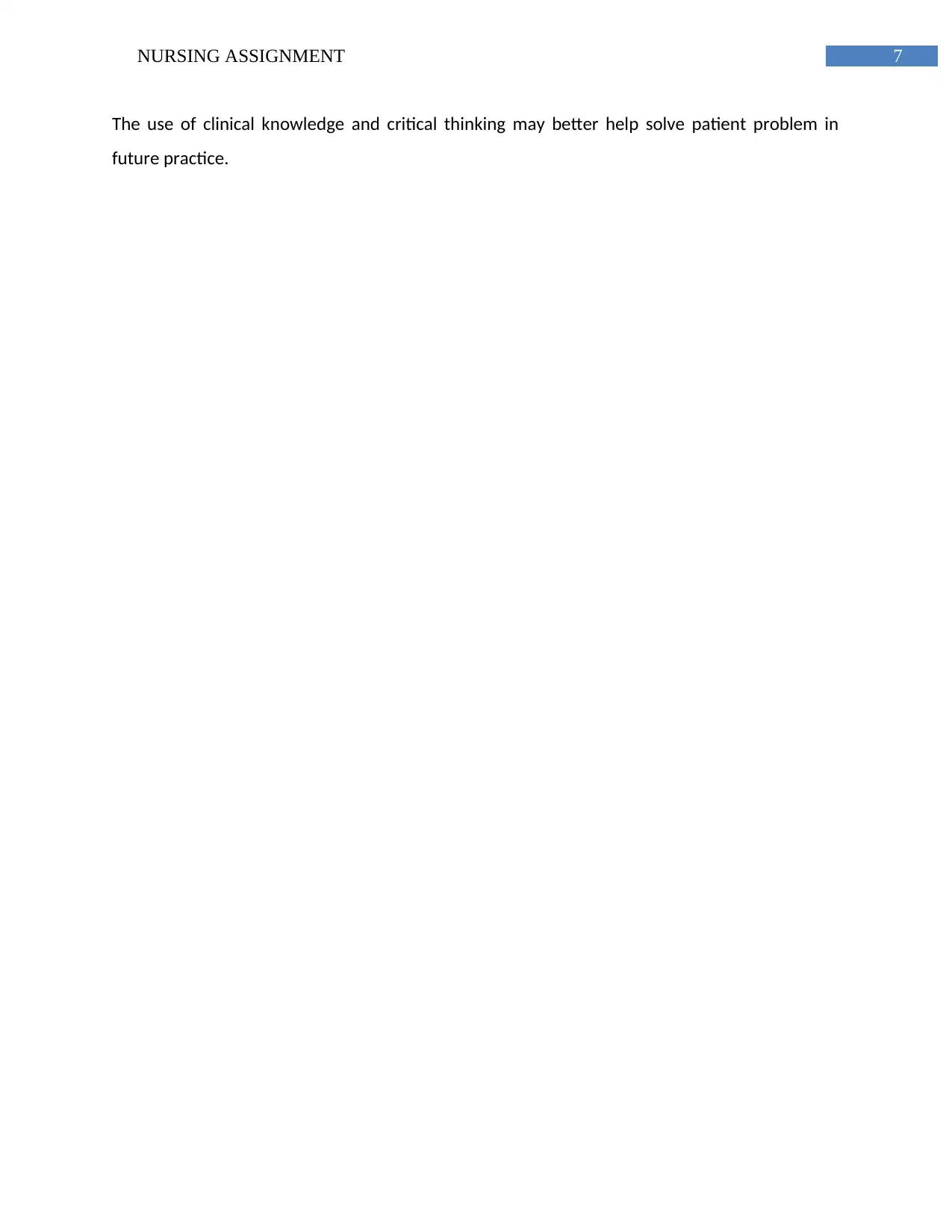
7NURSING ASSIGNMENT
The use of clinical knowledge and critical thinking may better help solve patient problem in
future practice.
The use of clinical knowledge and critical thinking may better help solve patient problem in
future practice.
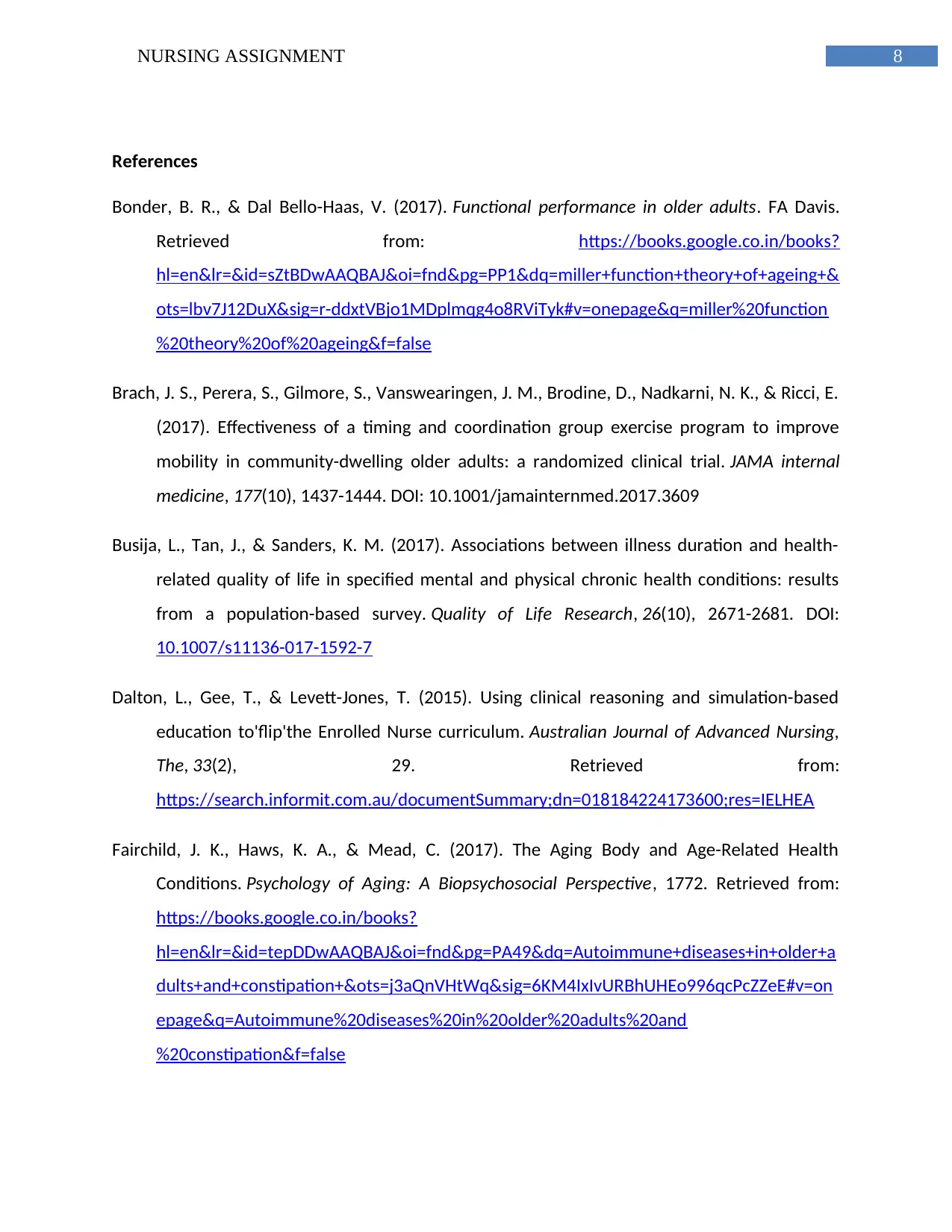
8NURSING ASSIGNMENT
References
Bonder, B. R., & Dal Bello-Haas, V. (2017). Functional performance in older adults. FA Davis.
Retrieved from: https://books.google.co.in/books?
hl=en&lr=&id=sZtBDwAAQBAJ&oi=fnd&pg=PP1&dq=miller+function+theory+of+ageing+&
ots=lbv7J12DuX&sig=r-ddxtVBjo1MDplmqg4o8RViTyk#v=onepage&q=miller%20function
%20theory%20of%20ageing&f=false
Brach, J. S., Perera, S., Gilmore, S., Vanswearingen, J. M., Brodine, D., Nadkarni, N. K., & Ricci, E.
(2017). Effectiveness of a timing and coordination group exercise program to improve
mobility in community-dwelling older adults: a randomized clinical trial. JAMA internal
medicine, 177(10), 1437-1444. DOI: 10.1001/jamainternmed.2017.3609
Busija, L., Tan, J., & Sanders, K. M. (2017). Associations between illness duration and health-
related quality of life in specified mental and physical chronic health conditions: results
from a population-based survey. Quality of Life Research, 26(10), 2671-2681. DOI:
10.1007/s11136-017-1592-7
Dalton, L., Gee, T., & Levett-Jones, T. (2015). Using clinical reasoning and simulation-based
education to'flip'the Enrolled Nurse curriculum. Australian Journal of Advanced Nursing,
The, 33(2), 29. Retrieved from:
https://search.informit.com.au/documentSummary;dn=018184224173600;res=IELHEA
Fairchild, J. K., Haws, K. A., & Mead, C. (2017). The Aging Body and Age-Related Health
Conditions. Psychology of Aging: A Biopsychosocial Perspective, 1772. Retrieved from:
https://books.google.co.in/books?
hl=en&lr=&id=tepDDwAAQBAJ&oi=fnd&pg=PA49&dq=Autoimmune+diseases+in+older+a
dults+and+constipation+&ots=j3aQnVHtWq&sig=6KM4IxIvURBhUHEo996qcPcZZeE#v=on
epage&q=Autoimmune%20diseases%20in%20older%20adults%20and
%20constipation&f=false
References
Bonder, B. R., & Dal Bello-Haas, V. (2017). Functional performance in older adults. FA Davis.
Retrieved from: https://books.google.co.in/books?
hl=en&lr=&id=sZtBDwAAQBAJ&oi=fnd&pg=PP1&dq=miller+function+theory+of+ageing+&
ots=lbv7J12DuX&sig=r-ddxtVBjo1MDplmqg4o8RViTyk#v=onepage&q=miller%20function
%20theory%20of%20ageing&f=false
Brach, J. S., Perera, S., Gilmore, S., Vanswearingen, J. M., Brodine, D., Nadkarni, N. K., & Ricci, E.
(2017). Effectiveness of a timing and coordination group exercise program to improve
mobility in community-dwelling older adults: a randomized clinical trial. JAMA internal
medicine, 177(10), 1437-1444. DOI: 10.1001/jamainternmed.2017.3609
Busija, L., Tan, J., & Sanders, K. M. (2017). Associations between illness duration and health-
related quality of life in specified mental and physical chronic health conditions: results
from a population-based survey. Quality of Life Research, 26(10), 2671-2681. DOI:
10.1007/s11136-017-1592-7
Dalton, L., Gee, T., & Levett-Jones, T. (2015). Using clinical reasoning and simulation-based
education to'flip'the Enrolled Nurse curriculum. Australian Journal of Advanced Nursing,
The, 33(2), 29. Retrieved from:
https://search.informit.com.au/documentSummary;dn=018184224173600;res=IELHEA
Fairchild, J. K., Haws, K. A., & Mead, C. (2017). The Aging Body and Age-Related Health
Conditions. Psychology of Aging: A Biopsychosocial Perspective, 1772. Retrieved from:
https://books.google.co.in/books?
hl=en&lr=&id=tepDDwAAQBAJ&oi=fnd&pg=PA49&dq=Autoimmune+diseases+in+older+a
dults+and+constipation+&ots=j3aQnVHtWq&sig=6KM4IxIvURBhUHEo996qcPcZZeE#v=on
epage&q=Autoimmune%20diseases%20in%20older%20adults%20and
%20constipation&f=false
⊘ This is a preview!⊘
Do you want full access?
Subscribe today to unlock all pages.

Trusted by 1+ million students worldwide
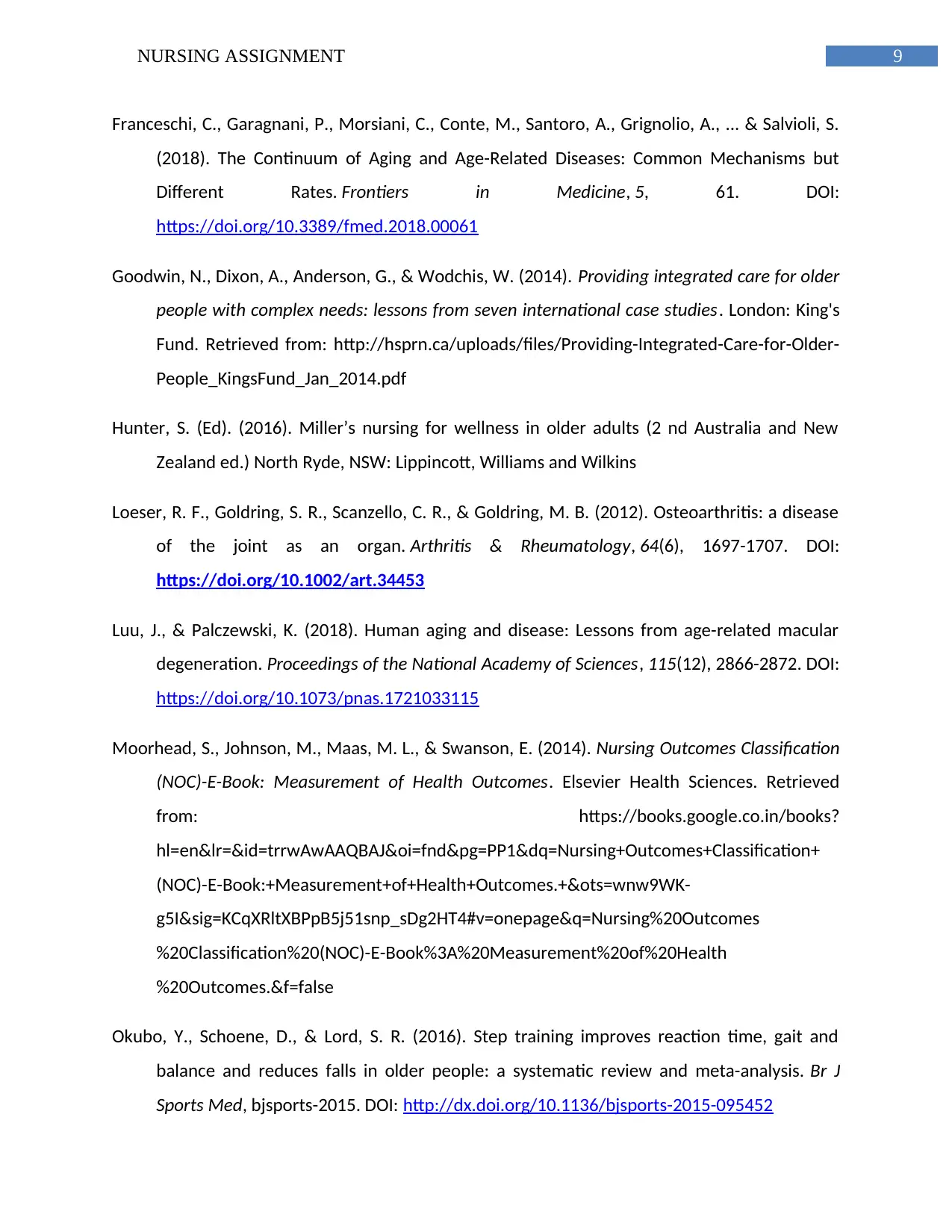
9NURSING ASSIGNMENT
Franceschi, C., Garagnani, P., Morsiani, C., Conte, M., Santoro, A., Grignolio, A., ... & Salvioli, S.
(2018). The Continuum of Aging and Age-Related Diseases: Common Mechanisms but
Different Rates. Frontiers in Medicine, 5, 61. DOI:
https://doi.org/10.3389/fmed.2018.00061
Goodwin, N., Dixon, A., Anderson, G., & Wodchis, W. (2014). Providing integrated care for older
people with complex needs: lessons from seven international case studies. London: King's
Fund. Retrieved from: http://hsprn.ca/uploads/files/Providing-Integrated-Care-for-Older-
People_KingsFund_Jan_2014.pdf
Hunter, S. (Ed). (2016). Miller’s nursing for wellness in older adults (2 nd Australia and New
Zealand ed.) North Ryde, NSW: Lippincott, Williams and Wilkins
Loeser, R. F., Goldring, S. R., Scanzello, C. R., & Goldring, M. B. (2012). Osteoarthritis: a disease
of the joint as an organ. Arthritis & Rheumatology, 64(6), 1697-1707. DOI:
https://doi.org/10.1002/art.34453
Luu, J., & Palczewski, K. (2018). Human aging and disease: Lessons from age-related macular
degeneration. Proceedings of the National Academy of Sciences, 115(12), 2866-2872. DOI:
https://doi.org/10.1073/pnas.1721033115
Moorhead, S., Johnson, M., Maas, M. L., & Swanson, E. (2014). Nursing Outcomes Classification
(NOC)-E-Book: Measurement of Health Outcomes. Elsevier Health Sciences. Retrieved
from: https://books.google.co.in/books?
hl=en&lr=&id=trrwAwAAQBAJ&oi=fnd&pg=PP1&dq=Nursing+Outcomes+Classification+
(NOC)-E-Book:+Measurement+of+Health+Outcomes.+&ots=wnw9WK-
g5I&sig=KCqXRltXBPpB5j51snp_sDg2HT4#v=onepage&q=Nursing%20Outcomes
%20Classification%20(NOC)-E-Book%3A%20Measurement%20of%20Health
%20Outcomes.&f=false
Okubo, Y., Schoene, D., & Lord, S. R. (2016). Step training improves reaction time, gait and
balance and reduces falls in older people: a systematic review and meta-analysis. Br J
Sports Med, bjsports-2015. DOI: http://dx.doi.org/10.1136/bjsports-2015-095452
Franceschi, C., Garagnani, P., Morsiani, C., Conte, M., Santoro, A., Grignolio, A., ... & Salvioli, S.
(2018). The Continuum of Aging and Age-Related Diseases: Common Mechanisms but
Different Rates. Frontiers in Medicine, 5, 61. DOI:
https://doi.org/10.3389/fmed.2018.00061
Goodwin, N., Dixon, A., Anderson, G., & Wodchis, W. (2014). Providing integrated care for older
people with complex needs: lessons from seven international case studies. London: King's
Fund. Retrieved from: http://hsprn.ca/uploads/files/Providing-Integrated-Care-for-Older-
People_KingsFund_Jan_2014.pdf
Hunter, S. (Ed). (2016). Miller’s nursing for wellness in older adults (2 nd Australia and New
Zealand ed.) North Ryde, NSW: Lippincott, Williams and Wilkins
Loeser, R. F., Goldring, S. R., Scanzello, C. R., & Goldring, M. B. (2012). Osteoarthritis: a disease
of the joint as an organ. Arthritis & Rheumatology, 64(6), 1697-1707. DOI:
https://doi.org/10.1002/art.34453
Luu, J., & Palczewski, K. (2018). Human aging and disease: Lessons from age-related macular
degeneration. Proceedings of the National Academy of Sciences, 115(12), 2866-2872. DOI:
https://doi.org/10.1073/pnas.1721033115
Moorhead, S., Johnson, M., Maas, M. L., & Swanson, E. (2014). Nursing Outcomes Classification
(NOC)-E-Book: Measurement of Health Outcomes. Elsevier Health Sciences. Retrieved
from: https://books.google.co.in/books?
hl=en&lr=&id=trrwAwAAQBAJ&oi=fnd&pg=PP1&dq=Nursing+Outcomes+Classification+
(NOC)-E-Book:+Measurement+of+Health+Outcomes.+&ots=wnw9WK-
g5I&sig=KCqXRltXBPpB5j51snp_sDg2HT4#v=onepage&q=Nursing%20Outcomes
%20Classification%20(NOC)-E-Book%3A%20Measurement%20of%20Health
%20Outcomes.&f=false
Okubo, Y., Schoene, D., & Lord, S. R. (2016). Step training improves reaction time, gait and
balance and reduces falls in older people: a systematic review and meta-analysis. Br J
Sports Med, bjsports-2015. DOI: http://dx.doi.org/10.1136/bjsports-2015-095452
Paraphrase This Document
Need a fresh take? Get an instant paraphrase of this document with our AI Paraphraser

10NURSING ASSIGNMENT
Stubbs, B., Binnekade, T., Eggermont, L., Sepehry, A. A., Patchay, S., & Schofield, P. (2014). Pain
and the risk for falls in community-dwelling older adults: systematic review and meta-
analysis. Archives of physical medicine and rehabilitation, 95(1), 175-187.
DOI: https://doi.org/10.1016/j.apmr.2013.08.241
Tzeng, H. M., & Yin, C. Y. (2014). Most and least helpful aspects of fall prevention education to
prevent injurious falls: a qualitative study on nurses' perspectives. Journal of clinical
nursing, 23(17-18), 2676-2680. DOI: https://doi.org/10.1111/jocn.12295
Yost, J., Ganann, R., Thompson, D., Aloweni, F., Newman, K., Hazzan, A., ... & Ciliska, D. (2015).
The effectiveness of knowledge translation interventions for promoting evidence-
informed decision-making among nurses in tertiary care: a systematic review and meta-
analysis. Implementation Science, 10(1), 98.DOI: https://doi.org/10.1186/s13012-015-
0286-1
Stubbs, B., Binnekade, T., Eggermont, L., Sepehry, A. A., Patchay, S., & Schofield, P. (2014). Pain
and the risk for falls in community-dwelling older adults: systematic review and meta-
analysis. Archives of physical medicine and rehabilitation, 95(1), 175-187.
DOI: https://doi.org/10.1016/j.apmr.2013.08.241
Tzeng, H. M., & Yin, C. Y. (2014). Most and least helpful aspects of fall prevention education to
prevent injurious falls: a qualitative study on nurses' perspectives. Journal of clinical
nursing, 23(17-18), 2676-2680. DOI: https://doi.org/10.1111/jocn.12295
Yost, J., Ganann, R., Thompson, D., Aloweni, F., Newman, K., Hazzan, A., ... & Ciliska, D. (2015).
The effectiveness of knowledge translation interventions for promoting evidence-
informed decision-making among nurses in tertiary care: a systematic review and meta-
analysis. Implementation Science, 10(1), 98.DOI: https://doi.org/10.1186/s13012-015-
0286-1
1 out of 11
Related Documents
Your All-in-One AI-Powered Toolkit for Academic Success.
+13062052269
info@desklib.com
Available 24*7 on WhatsApp / Email
![[object Object]](/_next/static/media/star-bottom.7253800d.svg)
Unlock your academic potential
Copyright © 2020–2025 A2Z Services. All Rights Reserved. Developed and managed by ZUCOL.



